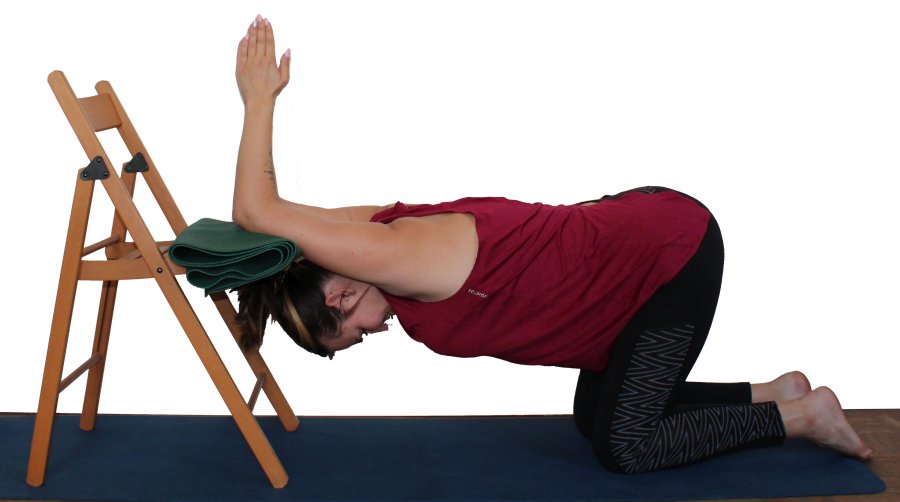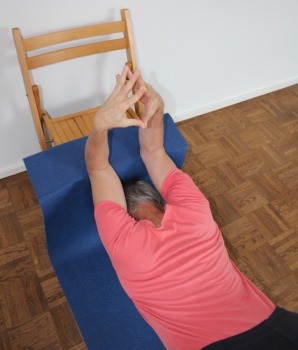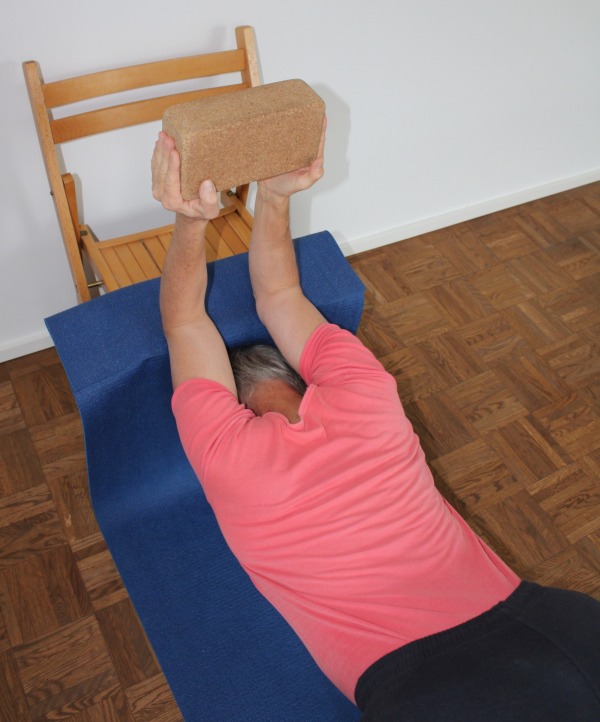yogabuch / asanas / shoulder opening on the chair
„shoulder opening on the chair“

 instructions and details with working links as PDF for download/print
instructions and details with working links as PDF for download/print
Detailfotos
Increase 1: Press fingertips | Increase 2: Hold block | Increase 3: Press block |
Feedback: We would love to hear what you think about this description, give us feedback at:
postmeister@yogabook.org
last update: 30.12.2018
Trivia name: Shoulder opening on the chair
Level: A
- Classification: A
- Contraindication
- Effects of
- Preparation
- follow-up
- derived asanas
- similar asanas
- diagnostics
- Instruction
- details
- Variants
Classification
classic: functional exercise
Contraindication
Effects
- (221) Shoulder blade: stretching for protraction
- (231) Shoulder joint: stretch for frontal abduction
- (271) Shoulder joint: stretch for exorotation
- (501) Stretch of the latissimus dorsi
- (511) Stretch of the pectoralis major
Preparation
As this is a very intensive posture to promote the ability to stretch the shoulder joint in the direction of frontal abduction, it can be warmed up first and stretched well in advance:
- Head down dog as a general stretch of the shoulder
- Dog headdown, especially the „wide“ variation as a general stretch of the muscles of the shoulder joint and the hamstrings
- Dog headup as a posture that prepares the shoulders for powerful work, especially through correctly executed transitions from and to downface dog, thus warming up the shoulder muscles
- Back extension, especially the „elevated“ version as a general stretching of the muscles of the shoulder joint
- Right-angled handstand as a related posture, which generally only differs in the rotation of the arms
- Handstand as a very related and highly synergistic posture
- Dog elbow stand as a very related and highly synergistic pose
- Elbowstand as a very related and highly synergistic pose
- right-angled el bow stand as a related posture, which generally only differs in the rotation of the arms
- hyperbola as one of the most effective and efficient stretches in the direction of frontal abduction without exorotation of the arms
- purvottanasana if the tone in the deltoid is too high or has become too high due to preparation
Follow-up
derived asanas:
similar asanas:
Diagnostics (No.)
The flexibility of the shoulder joint in the direction of frontal abduction can be recognized very well here, including side discrepancies. There may be indications of diseases of the shoulder:
- Irritable hypertonus of the deltoid: ambitious beginners in yoga in particular tend to develop irritation in the deltoid, which is localized in the area of the muscle origins, presumably due to overstraining of the structures through frequent repetitive demands in full frontal abduction and is also noticeable under the same load, see FAQ.
- Various pathological changes in the shoulder joint such as impingement syndrome, frozen shoulder, calcification of the biceps tendon, which cannot all be discussed here and require clarification.
- side discrepancies in flexibility
(650) Kyphosis and lordosis of the spine:
Deviations from the expected shape of the spine (uniformly moderate concave shape) can be recognized here. In particular, a hyperkyphosis of the thoracic spine or reduced lordosis of the lumbar spine would be noticeable here. See also the FAQ.
(611) Pelvic obliquity/unequal shoulder height/scoliosis of the spine:
The lateral deviations of the spine from the median plane known as scolioses are also quite visible in this posture. See the FAQ.
Variants:
Instructions
- Place a chair with the backrest against the wall.
- Place your mat lengthwise in front of the chair, with the end of the mat folded once over the first 10 centimeters of the seat of the chair.
- Kneel in front of the chair.
- Place both elbows on the chair, the distance between the elbows is such that the head still fits through the upper arms: the elbows are close to the front edge of the seat, but in such a way that they cannot slip off.
- Put your head through your upper arms.
- Gradually place your knees further away from the chair until you have reached a distance at which the desired stretch in the shoulder area is achieved as you passively lower your upper body towards the floor.
Details
- It would be desirable for the arms to touch at the elbows, but this requires the shoulders to be mobile enough for the arms to be behind(dorsal) the head in the posture, otherwise the head between the arms would prevent the elbows from touching. In principle, however, this would take away little of the posture’s effect.
- Two things can be done to increase the effect:
- keep increasing the distance between the knees and the chair until the desired effect is achieved.
- Press the fingertips together and bend the fingers further and further so that eventually the wrists move further and further apart, which leads to increased rotation of the upper arms in the shoulders and a better stretching effect.
- Keep both the back and the gluteal muscles soft. The weight of the upper body should be able to work undiminished to promote flexibility in the shoulders.
- Keep the forearms vertical.
- Leaving the pose can sometimes make you feel its intensity again.
Variations
Press fingertips

Instructions
- Take the pose as described above.
- Spread the fingers, press the fingertips together, bend the fingers and bend the wrists palmarwards so that the wrists are as far apart as possible.
Details
- Both the flexion of the fingers and the palmar flexion of the wrists create space between the wrists and thus improve the exorotation of the upper arms in the shoulder joints, which intensifies the stretch.
Holding the block

Instructions
- Take the pose as described above, but hold a block between your hands after placing your elbows as close together as possible.
Details
- As a rule, the distance between the elbows cannot be significantly reduced if the block is already between the hands. The demand on the shoulder joint’s ability to exorotateis too great. A supporter must therefore pass the block after the elbows have been placed as close together as possible.
Press against the block

Instructions
- Take the pose described above.
- As in the last variation, a supporter must reach the block, which is then pressed against with the fingertips so that the wrists move apart as far as possible.
Details
- The movement of the wrists away from each other maximizes the possible exorotation in the shoulder joint in this position and thus stretches the powerful endorotating adductors of the shoulder joint such as the teres major and the latissimus dorsi in the best possible way.
- If there is high tone in the finger flexors, there is a risk that these muscles in the forearm will start to spasm. Stop the cramp as early as possible in its development.
(P)

Instructions
- Take the pose as described above.
- The supporter now carefully places one elbow further inwards after the other.
Details
- This support is all about overcoming the difficulty of placing the elbows as close together as possible on the chair. Depending on your flexibility and strength, you may not be able to do this on your own. The effectiveness of the posture comes purely from the gravity of the upper body and head. This should not normally be helped by pushing the upper body down, although very muscular and stiff people may be an exception. Usually, the effectiveness is determined by the performer themselves only by the extent to which they passively lower the upper body and the distance of the knees from the wall.
(P) with block

Instructions
- Take the pose as described above.
- The supporter carefully places one elbow further inwards after the other.
- Now carefully move the performer’s wrists apart and place a block between the fingertips against which the performer should press, moving the wrists further apart and increasing the exorotation of the upper arms in the shoulder joints.
Details
- This version is the same as the „fingertip press“ version, except that the fingers are pressed against a block instead of against each other, which increases the distance between the wrists and therefore the exorotation in the shoulders.
- Make sure to bend the fingers significantly and also bend the wrists palmarwards so that the wrists are as far apart as possible.
